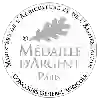
Château BelgraveHaut-Médoc (Grand Cru Classé)
This wine is a blend of 4 varietals which are the Cabernet franc, the Cabernet-Sauvignon, the Petit Verdot and the Merlot.
In the mouth this red wine is a powerful with a nice balance between acidity and tannins.
This wine generally goes well with poultry, beef or game (deer, venison).
The Haut-Médoc (Grand Cru Classé) of the Château Belgrave is in the top 20 of wines of Haut-Médoc.
Taste structure of the Haut-Médoc (Grand Cru Classé) from the Château Belgrave
Light | Bold | |
Smooth | Tannic | |
Dry | Sweet | |
Soft | Acidic |
In the mouth the Haut-Médoc (Grand Cru Classé) of Château Belgrave in the region of Bordeaux is a powerful with a nice balance between acidity and tannins.
Wine flavors and olphactive analysis
On the nose the Haut-Médoc (Grand Cru Classé) of Château Belgrave in the region of Bordeaux often reveals types of flavors of iron, graphite or earth and sometimes also flavors of non oak, oil or savory.
Food and wine pairings with Haut-Médoc (Grand Cru Classé)
Pairings that work perfectly with Haut-Médoc (Grand Cru Classé)
Original food and wine pairings with Haut-Médoc (Grand Cru Classé)
The Haut-Médoc (Grand Cru Classé) of Château Belgrave matches generally quite well with dishes of beef, lamb or game (deer, venison) such as recipes of beef pot au feu (grandma's style), ghormeh sabzi (iranian herbed lamb stew) or rabbit with prunes.
Details and technical informations about Château Belgrave's Haut-Médoc (Grand Cru Classé).
Discover the grape variety: Cabernet franc
Cabernet Franc is one of the oldest red grape varieties in Bordeaux. The Libourne region is its terroir where it develops best. The terroirs of Saint-Emilion and Fronsac allow it to mature and develop its best range of aromas. It is also the majority in many blends. The very famous Château Cheval Blanc, for example, uses 60% Cabernet Franc. The wines produced with Cabernet Franc are medium in colour with fine tannins and subtle aromas of small red fruits and spices. When blended with Merlot and Cabernet Sauvignon, it brings complexity and a bouquet of aromas to the wine. It produces fruity wines that can be drunk quite quickly, but whose great vintages can be kept for a long time. It is an earlier grape variety than Cabernet Sauvignon, which means that it is planted as far north as the Loire Valley. In Anjou, it is also used to make sweet rosé wines. Cabernet Franc is now used in some twenty countries in Europe and throughout the world.
Last vintages of this wine
The best vintages of Haut-Médoc (Grand Cru Classé) from Château Belgrave are 1990, 1979, 1989, 1986 and 2002.
Informations about the Château Belgrave
The Château Belgrave is one of of the world's greatest estates. It offers 2 wines for sale in the of Haut-Médoc to come and discover on site or to buy online.
The wine region of Haut-Médoc
The wine region of Haut-Médoc is located in the region of Médoc of Bordeaux of France. Wineries and vineyards like the Château Lestage Simon or the Château La Lagune produce mainly wines red, white and pink. The most planted grape varieties in the region of Haut-Médoc are Cabernet-Sauvignon, Merlot and Cabernet franc, they are then used in wines in blends or as a single variety. On the nose of Haut-Médoc often reveals types of flavors of leather, sour cherry or almonds and sometimes also flavors of chalk, hay or orange.
The wine region of Bordeaux
Bordeaux, in southwestern France, is one of the most famous, prestigious and prolific wine regions in the world. The majority of Bordeaux wines (nearly 90% of the production Volume) are the Dry, medium and Full-bodied red Bordeaux blends for which it is famous. The finest (and most expensive) are the wines of the great châteaux of Haut-Médoc and the right bank appellations of Saint-Émilion and Pomerol. The former focuses (at the highest level) on Cabernet Sauvignon, the latter on Merlot.
News related to this wine
An overview of Mâcon plus a geographical denomination appellation
The Bourgogne Wine Board (BIVB) invites you to a survey of this vineyard where the 27 geographical denominations of the Mâcon appellation are produced. A unique journey to discover this region where the Romanesque churches punctuate the landscape and are the witnesses of the link between the vines and Christiannity. Cluny is the gatekeeper. Our social media: Facebook: https://www.facebook.com/BourgogneWines Twitter: https://twitter.com/BourgogneWines/ Instagram: https://www.instagram.com/vin ...
The Rully appellation seen by Felix Debavelaere
Felix Debavelaere, from Domaine Rois Mages mentions the different personnalities of the Rully appellation. It is not easy to put it in a single box, not only because it can be produced in red and white but also because the wines can show different characters according to where the vines are planted. This video is taken from the “Rendez-vous avec les vins de Bourgogne” program (February 2021). Our social media: Facebook: https://www.facebook.com/BourgogneWines Twitter: https://twitter.com/Bourgo ...
At the heart of the terroirs of Mâcon-Pierreclos
Sequence from the video « At the heart of the Mâcon terroir » which offer a stroll at the heart of the Mâcon terroir. It offers a focus on Mâcon-Pierreclos, one of the 27 geographical denominations of the Mâcon appellation. Travel through the terroirs of the Mâcon appellation by watching the full video : https://www.youtube.com/watch?v=GF20y1aBZh8 Both are availablein French and English. Our social media: Facebook: https://www.facebook.com/BourgogneWines Twitter: https://twitter.com/BourgogneW ...
The word of the wine: Serious
A Bordeaux term for small pebbles from the Pyrenees, eroded, rounded and transported by the Garonne to Aquitaine. They are mainly found on the left bank in the area.... known as the Graves, and further downstream in the Médoc. By extension, gravel is found in other regions, brought by other rivers or even glaciers.










